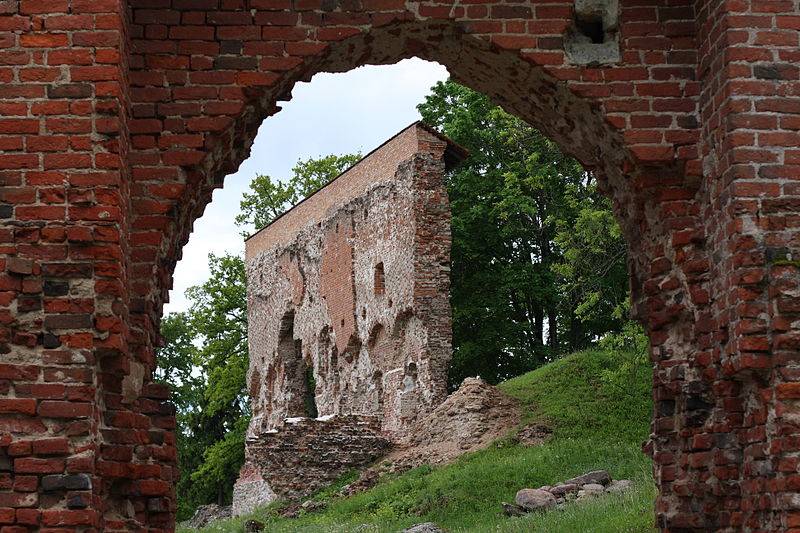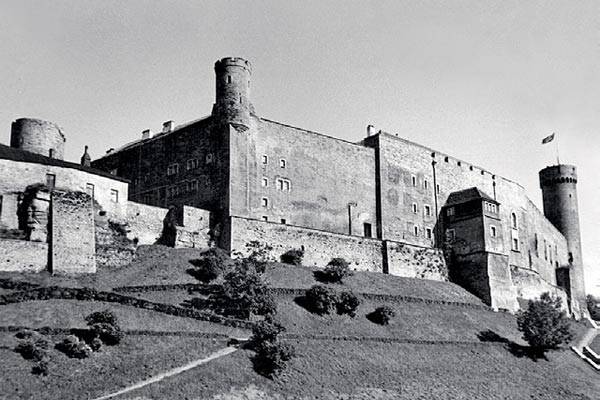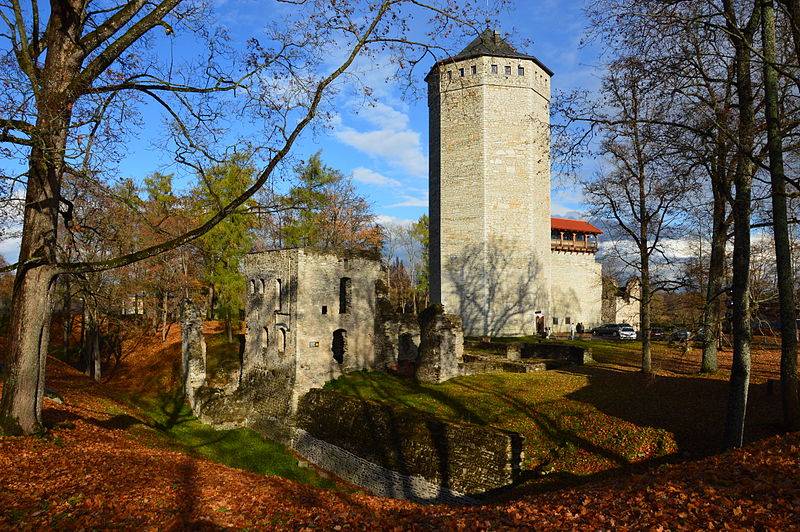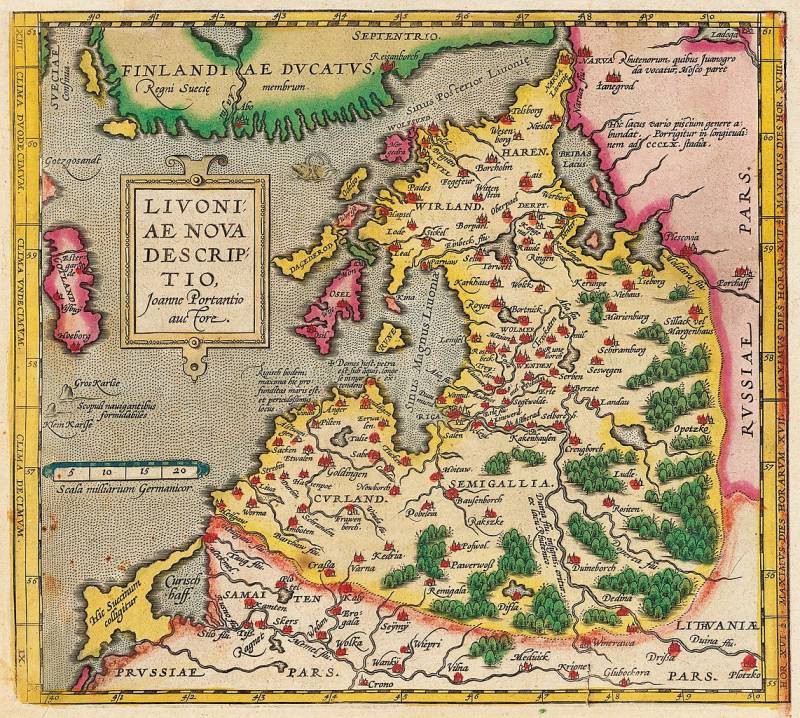The death of the Livonian army in the battle of Ermes

460 years ago, the Russian army destroyed the Livonian detachment in the battle of Ermes. This was the last rather large field battle of the war between the Russian kingdom and Livonia. The Order lost its combat-ready forces.
Spring Summer Campaign 1560
After the capture of Marienburg, the main forces of the Russian army were disbanded. But the border Russian garrisons did not sit outside the walls of the fortresses and still went to Livonia. Also, the Livonian borders disturbed the Pskov and Novgorod detachments. In the "German Land" there were "thugs" - hunters for other people's goods, who stole people and cattle. As a result, in the spring of 1560, Russian troops here and there invaded the possessions of the Order and the Archdiocese of Riga and devastated them. It is clear that the Livonians responded with their raids whenever possible.
Meanwhile, the Livonian War, which at the beginning was a local border conflict between Russia and Livonia, grew into a major war, primarily with the Grand Duchy of Lithuania. The Grand Duke of Lithuania Sigismund claimed the Livonian inheritance. In January 1560, an ambassador from the Grand Duke arrived in Moscow with a letter stating that Livonia was his "patrimony", and Russian troops should not fight the Livonian lands. Otherwise, Sigismund wrote to Ivan the Terrible, let him blame himself, he is the legitimate sovereign and sovereign of Livonia, is obliged to protect it. The threat was serious, and Moscow could not ignore it. But it was impossible to retreat either.
Therefore, the Russian government decided to put an end to the Livonian War before the situation became dangerous. Fighting with the Crimea, continuing to divert part of the forces to Livonia and also getting a war with Lithuania - it was stupid. Livonia had to be finished as soon as possible. Ivan Vasilievich decided to send two armies to Livonia. The first army was light. It was more of a reconnaissance trip - to probe the reaction of the Grand Duke of Lithuania. The army consisted of four regiments and seven governors, plus troops from Yuriev and the Tatar cavalry. Russian troops were led by Prince A. M. Kurbsky. In June 1560, his army twice invaded Livonia. The first raid was in the area of the Paide castle (Weissenstein), where the Livonian detachment (4 cavalry and 5 foot companies) was defeated. The second raid is to Fellin. Under its walls, a German detachment was defeated under the command of the old master Furstenberg. Then the Russian troops returned "with great wealth and greed" to Yuryev. In total, as Kurbsky later recalled, he beat the enemy seven or eight times.
At the same time, Ivan Vasilyevich exhibited a large army. It consisted of five main regiments (Big, Right and Left hand, Front and Sentinel). There were not ten governors in it, as usual (two per regiment), but 17, plus 2 governors with a dress (artillery) and 2 with Tatar cavalry. 70 heads walked under them, that is, the children of the boyars in the army were up to 7 thousand people, along with servants up to 8-9 thousand. Also Kazan and service Tatars, archers and Cossacks. That is, the army numbered up to 15-16 thousand soldiers, maybe more, not counting transport, koshevoy and other service and support personnel. Which, by the way, if necessary, could become combat, especially in defense. Kurbsky, embellishing as usual, although not as brazenly as the Germans, estimated the number of the Russian army at 30 thousand horsemen and 10 thousand archers and Cossacks. According to the Livonians, Ivan the Terrible put up 150 thousand. army. The army had about 90 cannons (including about 40 siege guns). The army was led by Prince I. F. Mstislavsky, his comrade-deputy was the artillery specialist boyar M. Ya. Morozov. Among the governors were also Prince P. Shuisky, A. Basmanov, Kurbsky, Alexei and Danila Adashev.
The Livonians knew about the approaching storm. However, the Livonian Confederation entered a new campaign completely demoralized by internal discord. The struggle of various parties, disunity and selfishness in Livonia reached their peak. Kettler was at enmity with Fürstenberg. The master was dissatisfied with the appearance of Duke Magnus (brother of the Danish king) in Ezel and the Swedes in Reval, constantly faced with opposition in Reval, Riga and other cities. Kettler did not have troops and money, he asked for help from Poland, Prussia and the German emperor. True, there was no sense in these appeals. The Prussian duke and the German emperor were unable to help Kettler. And the Polish king Sigismund was in no hurry to fight Russia. He preferred to gradually absorb the crumbling Livonia, occupying the castles with his garrisons. Also, the Polish treasury was empty, there was no money for the maintenance of the army and for the war. The king benefited from the further collapse of the Livonian Confederation. He preferred to wait for the Russians to put even more pressure on the Livonians and they become even more accommodating. Finally, Sigismund did not want to prematurely break the truce with Moscow.
Thus, Kettler experienced great problems in the formation and maintenance of the army. Most of the lands of the Order, still subject to the master, were ravaged and devastated by the war. Moreover, in 1560 there was a poor harvest. There was no money, equipment, food and fodder for the maintenance of the hired German Reitars and Landsknechts. The Lithuanian and Prussian subsidies received on the security of castles and lands have ended. There were no new ones. As a result, some of the mercenaries deserted, turned into marauders who plundered the Livonian lands. There was no hope for the remaining soldiers; they were ready to revolt or flee at any moment. As a result, Livonia did not have a strong, combat-ready army during the 1560 campaign.
Battle of Ermes
In July 1560, the Russian army launched an offensive, targeting Fellin. It was the possession of the old master von Fürstenberg. He was stationed there with his knights, soldiers, with heavy and light artillery of the Order. The lands around Fellin were rich and little ravaged by war, which made it possible to maintain a court and a garrison. Fürstenberg himself, feeling that clouds were gathering over his residence, decided to leave the castle, and also take out the artillery and property from there to the Gapsal fortress on the coast. But he didn't have time. At the direction of the Russian commander-in-chief Mstislavsky, a light equestrian army marched ahead of the Russian army under the command of Prince Barbashin. On July 22, 1560, the Russian cavalry reached Fellin.
The main forces of the Russian army marched towards Fellin slowly, by several roads. So, the infantry and artillery on plows were transported up the Embach River to Lake Vincerv, then along the Tianassilma River almost to Fellin itself. The main forces (cavalry), led by Mstislavsky, went along the land road. As the main forces moved, the light army advanced to the south, covering the army in the Fellin direction from the south and south-west. It was the light army of Prince Vasily Barbashin who destroyed the remnants of the Order's field forces.
A detachment of order and Riga troops under the command of Land Marshal Philip von Belle (500 horsemen and 400-500 infantrymen) moved to the area of the small castle of Ermes to destroy the Russians who appeared there. In the morning skirmish on August 2, 1560, the German patrol captured several prisoners, who reported that they were opposed by a small Russian detachment (500 people). The Livonians decided to attack the enemy. The Germans crushed one of Barbashin's regiments, and apparently believed that the enemy had been defeated. Meanwhile, other regiments of the Russian army quickly regrouped and counterattacked. The Livonians were surrounded. The defeat of von Belle's troops was complete. The Germans lost, according to various sources, from 261 to 500 people. Several commissars and hauptmans were killed and captured. The land marshal himself and other noble Livonians were captured by the priests.
The effect of the defeat at Ermes was great. The Order lost its last combat-ready forces. Riga and Revel still had the means to wage war, to hire soldiers, but the will to fight was suppressed. The land marshal himself, apparently, was from the party of the "irreconcilable", so he was executed in Moscow. Failure followed failure. Soon the Russians took Fellin and captured the old master.
Fall of Fellin
After the defeat of the Livonians at Ermes, siege work at Fellin intensified. Gunners, archers and Cossacks carried out engineering work, fired at the fortress day and night. At this time, the cavalry devastated the surroundings. The Russians reached Karkus, Ruen, Venden and Volmar. Kurbsky himself, boasting as usual (in particular, attributing to himself other people's successes), wrote that he beat the Livonians and Lithuanians at Venden, and at Volmar he defeated the new order land marshal.
The bombardment of the city and the castle for many days yielded results. The walls were broken in many places. On the night of August 18, a strong fire broke out in the city. The fire was not extinguished and the whole city was burnt out, only a few houses remained. After the fall of the city, the castle was doomed. No outside help was expected. The mercenaries did not want to die and, under the pretext of lack of salary, revolted. Furstenberg promised to bail gold and silver things, jewelry. But the soldiers refused to obey, entered into negotiations with the Russians, got themselves free passage with their property and surrendered the castle. Before leaving Fellin, the mercenaries plundered him, took the treasury and property of the old master, many noble nobles, dignitaries of the Order and burghers-citizens. They stole for 5 or even 10 years of service. However, the good triumphed. Along the way, Russians or Tatars robbed the Landsknechts, "leaving them naked and barefoot." To complete their troubles, Master Kettler punished the rebels: the leaders of the riot were on the wheel, and the rest were hanged.
As a result, on August 20 (according to other sources, on the 21st or 22nd) Fellin capitulated, the Russians entered the fortress. Johann von Furstenberg was taken prisoner, he was sent to Moscow. The victory was significant. Fellin Fortress was of strategic importance. The trophies were the best artillery of the Order, including 18 siege weapons, more gunpowder, etc.

The ruin of the German land. Unsuccessful siege of Paida
In the wake of another victory, the boyars Mstislavsky and Shuisky sent a letter to Revel, in which they suggested that the residents of the city beat Ivan IV Vasilyevich with their foreheads about transferring to his citizenship. Similar letters were sent to other cities. So that the Germans had no doubts about the seriousness of the intentions of the Russian tsar, our troops continued the pogrom of Livonia. Two large Russian detachments were sent to Oberpalen and Tarvast. Another host began to ravage the area between Karkus, Pernov and Ruen.
On September 3, 1560, a detachment of Prince Fyodor Troyekurov burned down the Ruen castle. Before that, the princes Peter and Vasily of Rostov took Tarvast, and the light army of the boyar Yakovlev-Chiron and Prince Meshchersky severely devastated the vicinity of Pernov. The Russians reached Gapsal. On September 11, the Russian forward detachment reached the approaches to Revel, 10 versts from the city. The Revel garrison and volunteers from among the residents of the city made a sortie and defeated a small forward detachment, seizing its booty. However, the residents of Revel did not celebrate the victory for long. Yakovlev's detachment arrived in time and punished the Germans. According to the Pskov Chronicle, the losses of the Livonians were 300 horsemen and 400 footmen. Many noble gentlemen were killed. In a similar skirmish, the Livonians were defeated at Volmar. To complete all the misfortunes in Livonia, peasant riots began. The peasants rebelled against the noble gentlemen whom they served and paid taxes. The nobles could not cope with the task of protecting them. Therefore, the peasants decided not to obey the nobles and demanded freedom.
Obviously, after the capture of Fellin, Mstislavsky's army had to go to Kolyvan-Revel. It was necessary to forge the iron while it was hot. Until the enemy is defeated and demoralized, until the other powers entered the war. The capture of Reval was supposed to complete the Livonian campaign and solved a lot of problems. It was a strategic coastal fortress. Russia received, in addition to Narva, another large port on the coast. A strong position was also ensured for diplomatic bargaining over the Livonian inheritance. However, the Russian governors, apparently, after the capture of Fellin and other victories, were dizzy with success. It was decided to take the Paide Castle (White Stone) in passing.
On September 7-8, 1560, Mstislavsky's army went to the order's castle. However, the commandant of Paida von Oldenbockum turned out to be a man with an iron will. The Pskov Chronicle noted that the castle was strong and stood in the swamps, which limited the possibilities of the besiegers. The Russian outfit destroyed up to 60 feet (about 18 meters) of the fortress wall. But Oldenbockum and his men "fought hard for good and sat to death." The Livonians restored at night what the Russian artillery destroyed during the day. Numerous Russian troops could not besiege the castle for a long time. The area around was already ravaged by the war, problems began with the supply of food and fodder. Autumn thaw began, that is, it was difficult to deliver what was needed to Mstislavsky's camp.
On October 15, a heavy bombardment began, which lasted until 10 am the next day. Then the Russians went to storm. However, the Livonian commander made a coup. On the eve of the shelling, he took the men and guns out of the forward fortifications, and they were not injured. As soon as the Russians broke into the abandoned suburb, they came under targeted fire from the garrison, suffered heavy losses and retreated. On October 18, Mstislavsky lifted the siege and took the army away. With great difficulty, the artillery was taken to Yuryev, and then to Pskov.
The 1560 campaign was completed. Small skirmishes continued, but generally there was a lull. The Russian army dealt a mortal blow to the Livonian Confederation, although it could not solve all the problems. The first stage of the Livonian War (the war between Russia and Livonia) was coming to an end. The second was approaching.
Livonia's neighbors began to divide the country. Ezel's bishop sold the island of Ezel to Duke Magnus, brother of the Danish king. The new ruler of Ezel and Vic planned to capture Revel as well. Moreover, the local bishop Moritz Wrangel followed the example of his Ezel brother. True, the Danes did not succeed with Revel. Revel was the first to be captured by the Swedes. They took away the rich port city from under the noses not only of Magnus, but also of the Polish king Sigismund, who wanted to take Revel with the help of Master Kettler. The Polish king Sigismund did not fight the Swedish monarch Eric XIV, as he was busy seizing southern Livonia and preparing a war with Moscow.


Information